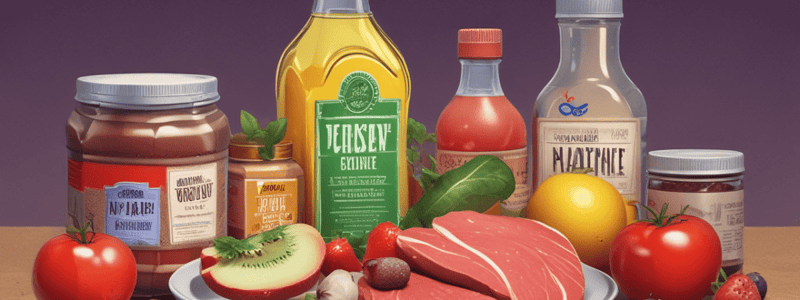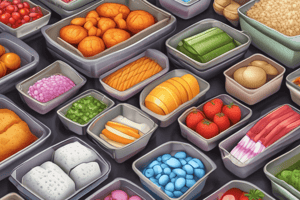Podcast
Questions and Answers
What is the challenge that the author faces with their children's breakfast?
What is the challenge that the author faces with their children's breakfast?
Getting the kids to eat healthy breakfast options.
What is the criteria the author's family uses to select cereals?
What is the criteria the author's family uses to select cereals?
Cereals with 5g of sugar or less per serving.
Why is it effective to engage kids in the process of getting healthier?
Why is it effective to engage kids in the process of getting healthier?
Because they are smart and eager, and they rise to the occasion.
What is the author's advice for people going into the grocery store to eat healthier?
What is the author's advice for people going into the grocery store to eat healthier?
Why should shoppers be cautious in the middle aisles of the supermarket?
Why should shoppers be cautious in the middle aisles of the supermarket?
What should shoppers be wary of on the front of packaging?
What should shoppers be wary of on the front of packaging?
Why is it important to check the nutrition facts box on packaging?
Why is it important to check the nutrition facts box on packaging?
What is the author's warning about the serving sizes listed on packaging?
What is the author's warning about the serving sizes listed on packaging?
What is the author's attitude towards processed foods?
What is the author's attitude towards processed foods?
What is the author's hope for the book's impact on readers?
What is the author's hope for the book's impact on readers?
What is the average American's annual consumption of cheese and sugar?
What is the average American's annual consumption of cheese and sugar?
What is the term used to describe the optimum amount of sugar in a product?
What is the term used to describe the optimum amount of sugar in a product?
What is the estimated value of the processed food industry?
What is the estimated value of the processed food industry?
How does the author describe the food companies in terms of their transparency?
How does the author describe the food companies in terms of their transparency?
What is the theme of Michael Moss's book, 'Salt Sugar Fat'?
What is the theme of Michael Moss's book, 'Salt Sugar Fat'?
What is the key factor that allows kosher salt to have a more intense flavor?
What is the key factor that allows kosher salt to have a more intense flavor?
What was the primary appeal of Lunchables to kids, according to the companies' research?
What was the primary appeal of Lunchables to kids, according to the companies' research?
Why do many scientists and food company executives avoid consuming their own products?
Why do many scientists and food company executives avoid consuming their own products?
What is the concern regarding the increase in foods that emulate fast food in grocery stores?
What is the concern regarding the increase in foods that emulate fast food in grocery stores?
What is the motivation behind food companies like Kraft's efforts to make their products healthier?
What is the motivation behind food companies like Kraft's efforts to make their products healthier?
What is the 'bliss point' in the context of food formulation, and how does it affect consumer behavior?
What is the 'bliss point' in the context of food formulation, and how does it affect consumer behavior?
How does the food industry use fat to make their products more appealing to consumers, and what are the consequences of this?
How does the food industry use fat to make their products more appealing to consumers, and what are the consequences of this?
What role does salt play in the food industry, and how do companies use it to their advantage?
What role does salt play in the food industry, and how do companies use it to their advantage?
Do some scientists believe that highly sugared and high-fat foods can be addictive, and why do they think this?
Do some scientists believe that highly sugared and high-fat foods can be addictive, and why do they think this?
How do companies like Cargill manipulate the physical shape of ingredients like salt to make them more appealing to consumers?
How do companies like Cargill manipulate the physical shape of ingredients like salt to make them more appealing to consumers?
What strategy does the author suggest for navigating the grocery store to make healthier choices?
What strategy does the author suggest for navigating the grocery store to make healthier choices?
What do the author's children enjoy eating for breakfast, and what is the benefit of this choice?
What do the author's children enjoy eating for breakfast, and what is the benefit of this choice?
What is the author's warning about the packaging of supposedly healthy foods?
What is the author's warning about the packaging of supposedly healthy foods?
What does the author suggest doing with the nutrition facts box on packaging?
What does the author suggest doing with the nutrition facts box on packaging?
What is the underlying message of the author's approach to healthy eating?
What is the underlying message of the author's approach to healthy eating?
What was the initial approach of Kraft and other companies to address obesity, and why did it fail?
What was the initial approach of Kraft and other companies to address obesity, and why did it fail?
What was the 'revolutionary' step taken by Kraft in reformulating its products?
What was the 'revolutionary' step taken by Kraft in reformulating its products?
What is the main conflict faced by the USDA, according to the author?
What is the main conflict faced by the USDA, according to the author?
What is the key issue with the pricing of food products, according to the author?
What is the key issue with the pricing of food products, according to the author?
Why does the author believe that change is possible in the food industry?
Why does the author believe that change is possible in the food industry?
What strategies do food companies use to make their products more appealing to consumers, and what are the consequences of these strategies?
What strategies do food companies use to make their products more appealing to consumers, and what are the consequences of these strategies?
How does the food industry's use of salt affect consumers, and what role does it play in the industry?
How does the food industry's use of salt affect consumers, and what role does it play in the industry?
What is the significance of the $1 trillion processed food industry, and how does it impact consumers' health?
What is the significance of the $1 trillion processed food industry, and how does it impact consumers' health?
Why is it difficult for people to control their eating habits, and what does this say about the food industry?
Why is it difficult for people to control their eating habits, and what does this say about the food industry?
What does the food industry's use of sugar and cheese reveal about its priorities, and what are the consequences of these priorities?
What does the food industry's use of sugar and cheese reveal about its priorities, and what are the consequences of these priorities?
What is the 'bliss point' and how do food companies use it to their advantage?
What is the 'bliss point' and how do food companies use it to their advantage?
What role does fat play in the food industry, and how do companies use it to their advantage?
What role does fat play in the food industry, and how do companies use it to their advantage?
What is the importance of salt in the food industry, and how do companies use it to their advantage?
What is the importance of salt in the food industry, and how do companies use it to their advantage?
Why do some scientists believe that highly sugared and high-fat foods can be addictive, and what is their advice to consumers?
Why do some scientists believe that highly sugared and high-fat foods can be addictive, and what is their advice to consumers?
How do food companies manipulate the physical shape of ingredients like salt to make them more appealing to consumers?
How do food companies manipulate the physical shape of ingredients like salt to make them more appealing to consumers?
What is the primary obstacle that Kraft and other companies face in reducing the amount of salt, sugar, and fat in their products, according to the text?
What is the primary obstacle that Kraft and other companies face in reducing the amount of salt, sugar, and fat in their products, according to the text?
Why is the USDA conflicted in its mission to promote healthy eating, according to the text?
Why is the USDA conflicted in its mission to promote healthy eating, according to the text?
What is the key change that needs to occur in the pricing of food products, according to the author?
What is the key change that needs to occur in the pricing of food products, according to the author?
What is the main challenge that families face when trying to make healthier choices in the grocery store, according to the text?
What is the main challenge that families face when trying to make healthier choices in the grocery store, according to the text?
What is the author's main hope for the future of the food industry, according to the text?
What is the author's main hope for the future of the food industry, according to the text?
What strategy does the author suggest for navigating the grocery store to make healthier choices, and why is it effective?
What strategy does the author suggest for navigating the grocery store to make healthier choices, and why is it effective?
What is the significance of the front of packaging, and how should consumers interpret the information presented there?
What is the significance of the front of packaging, and how should consumers interpret the information presented there?
Why is it important to engage kids in the process of making healthier choices, and what benefits can this approach bring?
Why is it important to engage kids in the process of making healthier choices, and what benefits can this approach bring?
What is the importance of checking the nutrition facts box on packaging, and what should consumers be aware of when interpreting the information?
What is the importance of checking the nutrition facts box on packaging, and what should consumers be aware of when interpreting the information?
What is the author's ultimate message about taking control of food choices, and what empowerment can readers gain from this perspective?
What is the author's ultimate message about taking control of food choices, and what empowerment can readers gain from this perspective?
How does the design of kosher salt contribute to its more intense flavor?
How does the design of kosher salt contribute to its more intense flavor?
What motivated the success of Lunchables among children, according to the companies' research?
What motivated the success of Lunchables among children, according to the companies' research?
Why do some scientists and food company executives avoid consuming their own products?
Why do some scientists and food company executives avoid consuming their own products?
What is the concern regarding the increase in foods that emulate fast food in grocery stores?
What is the concern regarding the increase in foods that emulate fast food in grocery stores?
What is the motivation behind Kraft's efforts to make their products healthier?
What is the motivation behind Kraft's efforts to make their products healthier?
Flashcards are hidden until you start studying




